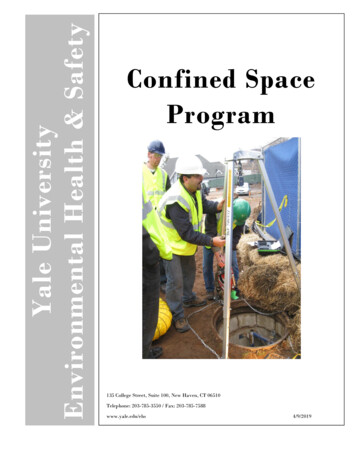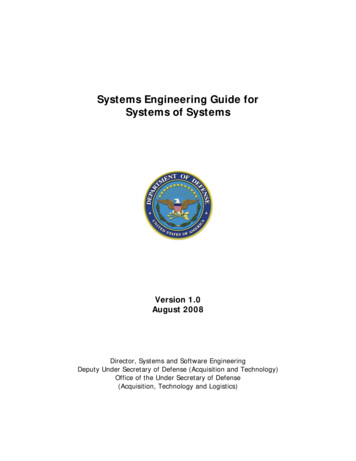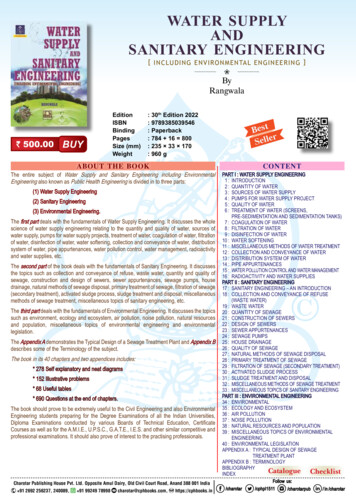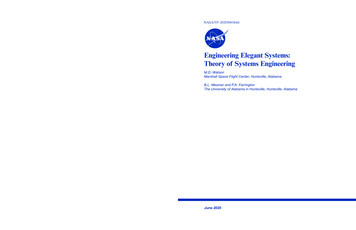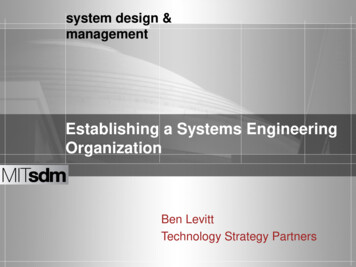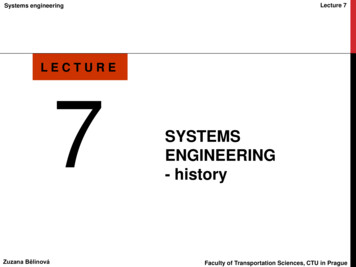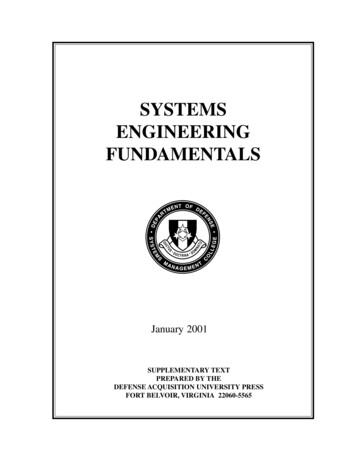
Transcription
IntroductionSystems Engineering FundamentalsSYSTEMSENGINEERINGFUNDAMENTALSJanuary 2001SUPPLEMENTARY TEXTPREPARED BY THEDEFENSE ACQUISITION UNIVERSITY PRESSFORT BELVOIR, VIRGINIA 22060-5565i
Systems Engineering FundamentalsIntroductionii
IntroductionSystems Engineering FundamentalsTABLE OFCONTENTSPREFACE . ivPART 1. INTRODUCTIONChapter 1.Introduction to Systems Engineering Management . 3Chapter 2.Systems Engineering Management in DoD Acquisition . 11PART 2. THE SYSTEMS ENGINEERING PROCESSChapter 3.Systems Engineering Process Overview . 31Chapter 4.Requirements Analysis . 35Chapter 5.Functional Analysis and Allocation . 45Chapter 6.Design Synthesis . 57Chapter 7.Verification . 65Chapter 8.Systems Engineering Process Outputs . 73PART 3. SYSTEM ANALYSIS AND CONTROLChapter 9.Work Breakdown Structure . 85Chapter 10. Configuration Management . 91Chapter 11. Technical Reviews and Audits . 99Chapter 12. Trade Studies . 111Chapter 13. Modeling and Simulation . 117Chapter 14. Metrics . 125Chapter 15. Risk Management . 133PART 4. PLANNING, ORGANIZING, AND MANAGINGChapter 16. Systems Engineering Planning . 147Chapter 17. Product Improvement Strategies . 157Chapter 18. Organizing and Integrating System Development . 171Chapter 19. Contractual Considerations . 185Chapter 20. Management Considerations and Summary . 201GLOSSARY . 209iii
Systems Engineering FundamentalsIntroductionPREFACEThis book provides a basic, conceptual-level description of engineering management disciplines thatrelate to the development and life cycle management of a system. For the non-engineer it provides anoverview of how a system is developed. For the engineer and project manager it provides a basic frameworkfor planning and assessing system development.Information in the book is from various sources, but a good portion is taken from lecture material developed for the two Systems Planning, Research, Development, and Engineering courses offered by theDefense Acquisition University.The book is divided into four parts: Introduction; Systems Engineering Process; Systems Analysis andControl; and Planning, Organizing, and Managing. The first part introduces the basic concepts thatgovern the systems engineering process and how those concepts fit the Department of Defense acquisitionprocess. Chapter 1 establishes the basic concept and introduces terms that will be used throughout thebook. The second chapter goes through a typical acquisition life cycle showing how systems engineeringsupports acquisition decision making.The second part introduces the systems engineering problem-solving process, and discusses in basicterms some traditional techniques used in the process. An overview is given, and then the process ofrequirements analysis, functional analysis and allocation, design synthesis, and verification is explainedin some detail. This part ends with a discussion of the documentation developed as the finished output ofthe systems engineering process.Part three discusses analysis and control tools that provide balance to the process. Key activities (such asrisk management, configuration management, and trade studies) that support and run parallel to thesystem engineering process are identified and explained.Part four discusses issues integral to the conduct of a systems engineering effort, from planning toconsideration of broader management issues.In some chapters supplementary sections provide related material that shows common techniques orpolicy-driven processes. These expand the basic conceptual discussion, but give the student a clearerpicture of what systems engineering means in a real acquisition environment.iv
Chapter 1Introduction to Systems EngineeringPART 1INTRODUCTION1
Systems Engineering FundamentalsChapter 12
Chapter 1Introduction to Systems EngineeringCHAPTER 1INTRODUCTION TOSYSTEMS ENGINEERINGMANAGEMENT1.1 PURPOSE499A, Engineering Management, 1 May 1974.Now cancelled.)The overall organization of this text is describedin the Preface. This chapter establishes some ofthe basic premises that are expanded throughoutthe book. Basic terms explained in this chapter arethe foundation for following definitions. Key systems engineering ideas and viewpoints are presented, starting with a definition of a system. An interdisciplinary approach that encompassesthe entire technical effort, and evolves into andverifies an integrated and life cycle balancedset of system people, products, and process solutions that satisfy customer needs. (EIA StandardIS-632, Systems Engineering, December 1994.) An interdisciplinary, collaborative approach thatderives, evolves, and verifies a life-cycle balanced system solution which satisfies customerexpectations and meets public acceptability.(IEEE P1220, Standard for Application andManagement of the Systems EngineeringProcess, [Final Draft], 26 September 1994.)1.2 DEFINITIONSA System Is Simply stated, a system is an integrated compositeof people, products, and processes that provide acapability to satisfy a stated need or objective.In summary, systems engineering is an interdisciplinary engineering management process thatevolves and verifies an integrated, life-cycle balanced set of system solutions that satisfy customerneeds.Systems Engineering Is Systems engineering consists of two significantdisciplines: the technical knowledge domain inwhich the systems engineer operates, and systemsengineering management. This book focuses onthe process of systems engineering management.Systems Engineering Management Is As illustrated by Figure 1-1, systems engineeringmanagement is accomplished by integrating threemajor activities:Three commonly used definitions of systemsengineering are provided by the best known technical standards that apply to this subject. They allhave a common theme: Development phasing that controls the designprocess and provides baselines that coordinatedesign efforts, A logical sequence of activities and decisionsthat transforms an operational need into a description of system performance parameters anda preferred system configuration. (MIL-STD- A systems engineering process that providesa structure for solving design problems and3
Systems Engineering FundamentalsChapter fe CyclePlanningLife CycleIntegrationFigure 1-1. Three Activities of Systems Engineering ManagementThe systems engineering process is the heart ofsystems engineering management. Its purpose isto provide a structured but flexible process thattransforms requirements into specifications, architectures, and configuration baselines. The discipline of this process provides the control and traceability to develop solutions that meet customerneeds. The systems engineering process may berepeated one or more times during any phase ofthe development process.tracking requirements flow through the designeffort, and Life cycle integration that involves customersin the design process and ensures that the systemdeveloped is viable throughout its life.Each one of these activities is necessary to achieveproper management of a development effort. Phasing has two major purposes: it controls the designeffort and is the major connection between the technical management effort and the overall acquisition effort. It controls the design effort by developing design baselines that govern each level ofdevelopment. It interfaces with acquisition management by providing key events in the development process, where design viability can be assessed. The viability of the baselines developed isa major input for acquisition management Milestone (MS) decisions. As a result, the timing andcoordination between technical developmentphasing and the acquisition schedule is critical tomaintain a healthy acquisition program.Life cycle integration is necessary to ensure thatthe design solution is viable throughout the life ofthe system. It includes the planning associated withproduct and process development, as well as theintegration of multiple functional concerns into thedesign and engineering process. In this manner,product cycle-times can be reduced, and the needfor redesign and rework substantially reduced.1.3 DEVELOPMENT PHASINGDevelopment usually progresses through distinctlevels or stages:4
Chapter 1Introduction to Systems Engineeringdescriptions, and the product baseline for the subsystem/component detail descriptions. Figure 1-2shows the basic relationships between the baselines.The triangles represent baseline control decisionpoints, and are usually referred to as technical reviews or audits. Concept level, which produces a system conceptdescription (usually described in a conceptstudy); System level, which produces a system description in performance requirement terms; andLevels of Development Considerations Subsystem/Component level, which producesfirst a set of subsystem and component productperformance descriptions, then a set ofcorresponding detailed descriptions of theproducts’ characteristics, essential for theirproduction.Significant development at any given level in thesystem hierarchy should not occur until the configuration baselines at the higher levels are considered complete, stable, and controlled. Reviewsand audits are used to ensure that the baselines areready for the next level of development. As will beshown in the next chapter, this review and auditprocess also provides the necessary assessment ofsystem maturity, which supports the DoDMilestone decision process.The systems engineering process is applied to eachlevel of system development, one level at a time,to produce these descriptions commonly calledconfiguration baselines. This results in a series ofconfiguration baselines, one at each developmentlevel. These baselines become more detailed witheach level.1.4 THE SYSTEMS ENGINEERINGPROCESSIn the Department of Defense (DoD) the configuration baselines are called the functional baselinefor the system-level description, the allocatedbaseline for the subsystem/ component performanceThe systems engineering process is a top-downcomprehensive, iterative and recursive problemConcept StudiesDESIGN DEFINITIONSystem Definiiton(Functional Baseline)DESIGN DEFINITIONDESIGN DEFINITIONFigure 1-2. Development Phasing5Preliminary Design(Allocated Baseline)Detail Design(Product Baseline)
Systems Engineering FundamentalsChapter 1solving process, applied sequentially through allstages of development, that is used to:During the systems engineering process architectures are generated to better describe and understand the system. The word “architecture” is usedin various contexts in the general field of engineering. It is used as a general description of howthe subsystems join together to form the system. Itcan also be a detailed description of an aspect of asystem: for example, the Operational, System, andTechnical Architectures used in Command, Control, Communications, Computers, Intelligence,Surveillance, and Reconnaissance (C4ISR), andsoftware intensive developments. However, Systems Engineering Management as developed inDoD recognizes three universally usable architectures that describe important aspects of the system:functional, physical, and system architectures. Thisbook will focus on these architectures as necessary components of the systems engineeringprocess. Transform needs and requirements into a set ofsystem product and process descriptions (adding value and more detail with each level ofdevelopment), Generate information for decision makers, and Provide input for the next level of development.As illustrated by Figure 1-3, the fundamental systems engineering activities are RequirementsAnalysis, Functional Analysis and Allocation, andDesign Synthesis—all balanced by techniques andtools collectively called System Analysis and Control. Systems engineering controls are used to trackdecisions and requirements, maintain technicalbaselines, manage interfaces, manage risks, trackcost and schedule, track technical performance,verify requirements are met, and review/audit theprogress.PROCESSINPUTThe Functional Architecture identifies and structures the allocated functional and performancerequirements. The Physical Architecture depicts theSystem Analysisand opFunctional Analysisand AllocationDesignLoopVerificationDesign SynthesisPROCESS OUTPUTFigure 1-3. The Systems Engineering Process6
Chapter 1Introduction to Systems Engineeringsystem product by showing how it is broken downinto subsystems and components. The SystemArchitecture identifies all the products (includingenabling products) that are necessary to supportthe system and, by implication, the processesnecessary for development, production/construction, deployment, operations, support, disposal,training, and verification. Technical specialty areas, such as safety, riskmanagement, quality, etc., or When appropriate, business areas such asfinance, cost/budget analysis, and contracting.Life Cycle FunctionsLife cycle functions are the characteristic actionsassociated with the system life cycle. As illustratedby Figure 1-4, they are development, productionand construction, deployment (fielding), operation, support, disposal, training, and verification.These activities cover the “cradle to grave” lifecycle process and are associated with major functional groups that provide essential support to thelife cycle process. These key life cycle functionsare commonly referred to as the eight primaryfunctions of systems engineering.Life Cycle IntegrationLife cycle integration is achieved through integrated development—that is, concurrent consideration of all life cycle needs during the development process. DoD policy requires integrateddevelopment, called Integrated Product and Product Development (IPPD) in DoD, to be practicedat all levels in the acquisition chain of commandas will be explained in the chapter on IPPD. Concurrent consideration of all life cycle needs can begreatly enhanced through the use of interdisciplinary teams. These teams are often referred to asIntegrated Product Teams (IPTs).The customers of the systems engineer performthe life-cycle functions. The system user’s needsare emphasized because their needs generate therequirement for the system, but it must be remembered that all of the life-cycle functional areasgenerate requirements for the systems engineering process once the user has established the basicneed. Those that perform the primary functionsalso provide life-cycle representation in designlevel integrated teams.The objective of an Integrated Product Team is to: Produce a design solution that satisfies initiallydefined requirements, and Communicate that design solution clearly,effectively, and in a timely manner.Primary Function DefinitionsMulti-functional, integrated teams:Development includes the activities required toevolve the system from customer needs to productor process solutions. Place balanced emphasis on product and processdevelopment, and Require early involvement of all disciplinesappropriate to the team task.Manufacturing/Production/Construction includes the fabrication of engineering test modelsand “brass boards,” low rate initial production,full-rate production of systems and end items, orthe construction of large or unique systems or subsystems.Design-level IPT members are chosen to meet theteam objectives and generally have distinctive competence in: Technical management (systems engineering),Deployment (Fielding) includes the activities necessary to initially deliver, transport, receive, process, assemble, install, checkout, train, operate,house, store, or field the system to achieve fulloperational capability. Life cycle functional areas (eight primaryfunctions),7
Systems Engineering FundamentalsDisposalChapter 1TrainingVerificationOperationSupport8 PrimaryLife roduction/ConstructionFigure 1-4. Primary Life Cycle FunctionsSystems Engineering ConsiderationsOperation is the user function and includesactivities necessary to satisfy defined operationalobjectives and tasks in peacetime and wartimeenvironments.Systems engineering is a standardized, disciplinedmanagement process for development of systemsolutions that provides a constant approach tosystem development in an environment of changeand uncertainty. It also provides for simultaneousproduct and process development, as well as acommon basis for communication.Support includes the activities necessary to provide operations support, maintenance, logistics,and material management.Disposal includes the activities necessary to ensurethat the disposal of decommissioned, destroyed,or irreparable system components meets allapplicable regulations and directives.Systems engineering ensures that the correcttechnical tasks get done during developmentthrough planning, tracking, and coordinating.Responsibilities of systems engineers include:Training includes the activities necessary toachieve and maintain the knowledge and skill levelsnecessary to efficiently and effectively performoperations and support functions. Development of a total system design solutionthat balances cost, schedule, performance, andrisk, Development and tracking of technicalinformation needed for decision making,Verification includes the activities necessary toevaluate progress and effectiveness of evolvingsystem products and processes, and to measurespecification compliance. Verification that technical solutions satisfycustomer requirements,8
Chapter 1Introduction to Systems Engineering Development of a system that can be producedeconomically and supported throughout the lifecycle,tracking and verification problems software development entails. In a like manner, all technologydomains are expected to bring their own uniqueneeds to the process. Development and monitoring of internal andexternal interface compatibility of the system and subsystems using an open systemsapproach,This book provides a conceptual-level descriptionof systems engineering management. The specifictechniques, nomenclature, and recommendedmethods are not meant to be prescriptive. Technical managers must tailor their systems engineering planning to meet their particular requirementsand constraints, environment, technical domain,and schedule/budget situation. Establishment of baselines and configurationcontrol, and Proper focus and structure for system and majorsub-system level design IPTs.However, the basic time-proven concepts inherentin the systems engineering approach must be retained to provide continuity and control. For complex system designs, a full and documented understanding of what the system must do shouldprecede development of component performancedescriptions, which should precede componentdetail descriptions. Though some parts of the system may be dictated as a constraint or interface, ingeneral, solving the design problem should startwith analyzing the requirements and determiningwhat the system has to do before physical alternatives are chosen. Configurations must be controlledand risk must be managed.1.5 GUIDANCEDoD 5000.2-R establishes two fundamentalrequirements for program management: It requires that an Integrated Product andProcess approach be taken to design whereverpracticable, and It requires that a disciplined systems engineering process be used to translate operationalneeds and/or requirements into a systemsolution.Tailoring of this process has to be done carefullyto avoid the introduction of substantial unseen riskand uncertainty. Without the control, coordination,and traceability of systems engineering, an environment of uncertainty results which will lead tosurprises. Experience has shown that thesesurprises almost invariably lead to significantimpacts to cost and schedule. Tailored processesthat reflect the general conceptual approach of thisbook have been developed and adopted by professional societies, academia, industry associations,government agencies, and major companies.Tailoring the ProcessSystem engineering is applied during all acquisition and support phases for large- and small-scalesystems, new developments or product improvements, and single and multiple procurements. Theprocess must be tailored for different needs and/orrequirements. Tailoring considerations includesystem size and complexity, level of systemdefinition detail, scenarios and missions, constraints and requirements, technology base, majorrisk factors, and organizational best practices andstrengths.1.6 SUMMARY POINTSFor example, systems engineering of softwareshould follow the basic systems engineeringapproach as presented in this book. However, itmust be tailored to accommodate the softwaredevelopment environment, and the unique progress Systems engineering management is a multifunctional process that integrates life cyclefunctions, the systems engineering problemsolving process, and progressive baselining.9
Systems Engineering FundamentalsChapter 1 The systems engineering process is a problem-solving process that drives the balanceddevelopment of system products and processes. Baseline phasing provides for an increasinglevel of descriptive detail of the products andprocesses with each application of the systemsengineering process. Integrated Product Teams should apply the systems engineering process to develop a life cyclebalanced-design solution. Baselining in a nut shell is a concept description that leads to a system definition which, inturn, leads to component definitions, and thento component designs, which finally lead to aproduct. The systems engineering process is applied toeach level of development, one level at a time. Fundamental systems engineering activities areRequirements Analysis, Functional Analysis/Allocation, and Design Synthesis, all of whichare balanced by System Analysis and Control. The output of each application of the systemsengineering process is a major input to the nextprocess application.10
Chapter 2Systems Engineering Management in DoD AcquisitionCHAPTER 2SYSTEMS ENGINEERINGMANAGEMENT INDOD ACQUISITIONestablish the broad responsibilities and groundrules to be followed in funding and acquiring majorassets. The departments of the executive branch ofgovernment are then expected to draft their ownguidance consistent with the guidelines established. The principal guidance for defense systemacquisitions is the DoD 5000 series of directivesand regulations. These documents reflect theactions required of DoD acquisition managers to:2.1 INTRODUCTIONThe DoD acquisition process has its foundation infederal policy and public law. The development,acquisition, and operation of military systems isgoverned by a multitude of public laws, formalDoD directives, instructions and manuals, numerous Service and Component regulations, and manyinter-service and international agreements.Managing the development and fielding of military systems requires three basic activities: technical management, business management, and contract management. As described in this book,systems engineering management is the technicalmanagement component of DoD acquisitionmanagement. Translate operational needs into stable,affordable programs,The acquisition process runs parallel to the requirements generation process and the budgeting process (Planning, Programming, and Budgeting System.) User requirements tend to be event drivenby threat. The budgeting process is date driven byconstraints of the Congressional calendar. SystemsEngineering Management bridges these processesand must resolve the dichotomy of event drivenneeds, event driven technology development, anda calendar driven budget.2.2 RECENT CHANGES Acquire quality products, and Organize for efficiency and effectiveness.The DoD 5000 series documents were revised in2000 to make the process more flexible, enablingthe delivery of advanced technology to warfightersmore rapidly and at reduced total ownership cost.The new process encourages multiple entry points,depending on the maturity of the fundamental technologies involved, and the use of evolutionary methods to define and develop systems. This encouragesa tailored approach to acquisition and engineeringmanagement, but it does not alter the basic logicof the underlying systems engineering process.Direction and GuidanceThe Office of Management and Budget (OMB)provides top-level guidance for planning, budgeting, and acquisition in OMB Circular A-11, Part3, and the Supplemental Capital ProgrammingGuide: Planning, Budgeting, and Acquisition ofCapital Assets, July 1997. These documents2.3 ACQUISITION LIFE CYCLEThe revised acquisition process for major defensesystems is shown in Figure 2-1. The process is11
Systems Engineering FundamentalsChapter 2 Process entry atMilestones A, B, or C(or within phases)Milestones Program outyear fundingwhen it makes sense, butno later than Milestone BABConcept IOCSystemDevelopment andDemonstrationSingle Step orEvolutionto Full CapacityProductionandDeploymentSystems Acquisition(Engineering Development, Demonstration,LRIP and ntenanceAll validated by JROCORDRelationship to Requirements ProcessFigure 2-1. Revised DoD 5000 Acquisition Processthe Concept and Technology Development phaseis made formally at the Milestone A forum.defined by a series of phases during which technology is defined and matured into viable concepts,which are subsequently developed and readied forproduction, after which the systems produced aresupported in the field.The Concept and Technology Developmentphase begins with concept exploration. During thisstage, concept studies are undertaken to define alternative concepts and to provide information aboutcapability and risk that would permit an objectivecomparison of competing concepts. A decisionreview is held after completion of the concept exploration activities. The purpose of this review isto determine whether further technology development is required, or whether the system is ready toenter into system acquisition. If the key technologies involved are reasonably mature and have already been demonstrated, the Milestone DecisionAuthority (MDA) may agree to allow the systemto proceed into system acquisition; if not, the system may be directed into a component advanceddevelopment stage. (See Supplement A to thischapter for a definition of Technology Readinesslevels.) During this stage, system architecture definition will continue and key technologies will bedemonstrated in order to ensure that technical andcost risks are understood and are at acceptable levels prior to entering acquisition. In any event, theThe process allows for a given system to enter theprocess at any of the development phases. For example, a system using unproven technology wouldenter at the beginning stages of the process andwould proceed through a lengthy period of technology maturation, while a system based on mature and proven technologies might enter directlyinto engineering development or, conceivably, evenproduction. The process itself (Figure 2-1) includesfour phases of development. The first, Conceptand Technology Development, is intended to explore alternative concepts based on assessmentsof operational needs, technology readiness, risk,and affordability. Entry into this phase does notimply that DoD has committed to a new acquisition program; rather, it is the initiation of a process to determine whether or not a need (typicallydescribed in a Mission Need Statement (MNS))can be met at reasonable levels of technical riskand at affordable costs. The decision to enter into12
Chapter 2Systems Engineering Management in DoD AcquisitionConcept and Technology Development phase endswith a defined system architecture supported bytechnologies that are at acceptable levels of maturity to justify entry into system acquisition.the process is a function of technology maturity,so the possibility exists that a system could enterdirectly into this phase if it were sufficiently mature, for example, a commercial product to be produced for defense applications. However the entr
Systems Engineering Fundamentals Chapter 1 4 Figure 1-1. Three Activities of Systems Engineering Management Development Phasing Baselines Life Cycle Planning Systems Engineering Process Life Cycle Integration Systems Engineering Management Integrated Teaming tracking requirements flow through the design effort, and Life cycle integration .

